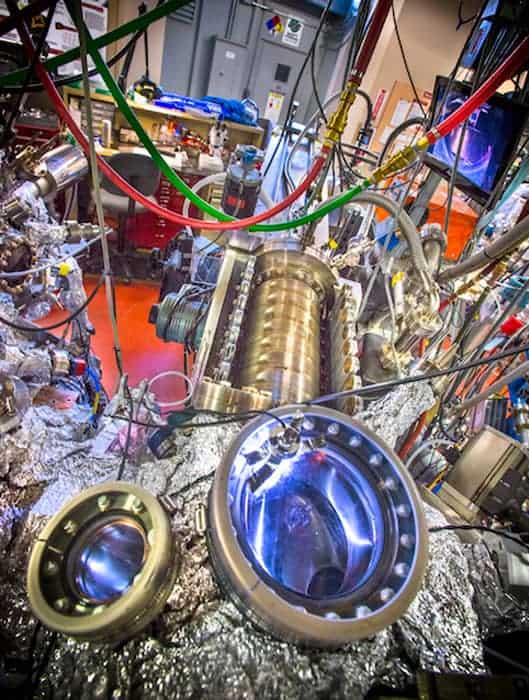
Three-dimensional analogues of graphene have been created independently by three groups of researchers. Like graphene, which can be considered a 2D system, electrons travel as massless particles through the new solids. The materials could help physicists to gain a better understanding of topological insulators and might also be used to create better computer hard drives.
Graphene is a layer of carbon just one atom thick and since it was first isolated in 2004 its remarkable electronic and mechanical properties have been studied by physicists worldwide. As well as providing a laboratory for studying the behaviour of electrons that are confined to 2D, graphene has also been touted as a replacement for silicon in electronic devices.
Graphene is different from most crystalline materials because its electrons are governed not by the standard Schrödinger equation, but instead by the Dirac equation of relativistic quantum mechanics. Dubbed a Dirac semimetal, its electrons travel effectively as massless particles, which allows them to reach much higher speeds than ordinary electrons – as high as 106 m s–1. As a result, the electron mobility in graphene is about 200,000 cm2/Vs, compared with about 1400 cm2/Vs in silicon.
Dirac semimetal in 3D
In graphene, this massless electronic transport can only occur within the planes of carbon atoms, making it an inherently 2D effect. However, in 2012 Charles Kane and colleagues at the University of Pennsylvania calculated that, in principle, it should be possible to produce a 3D Dirac semimetal. The Pennsylvania researchers used an allotrope of bismuth oxide as their computational model.
Intriguingly, their analysis also showed that such a material would have the “protected surface states” that are characteristic of a curious state of matter called a topological insulator. The strange electronic properties of topological insulators arise because the shape – or topology – of the electron energy bands makes it impossible for electrons moving along the surface to backscatter. As a result, a material that is an insulator in the bulk can be an excellent conductor on its surface.
These surface states have an interesting feature that is not present in other materials. The conduction electrons travel on the surface such that spin-up electrons move in one direction and spin-down electrons in the opposite direction. This is of great interest to researchers who are trying to develop spintronics devices, which use the spin of the electron to process and store information.
Made in the lab
Now, three groups have independently produced topological semimetals in the lab. One team includes Yulin Chen and scientists at SLAC National Accelerator Laboratory and the Lawrence Berkeley National Laboratory in California, the University of Oxford and Beijing National Laboratory for Condensed Matter Physics and Institute of Physics. Chen and colleagues did their experiments on sodium bismuthate. The second group included Zahid Hasan and colleagues at Princeton University in New Jersey, as well as colleagues in Massachusetts, Taiwan and Singapore. This group looked at cadmium arsenide, as did the third independent team, which included Robert Cava and colleagues at Princeton along with physicists at the Institute for Solid State Research in Dresden and the University of Dresden in Germany.
We may be able to make hard drives from Dirac semimetals that are smaller, higher density and have lower energy consumption
Yulin Chen, University of Oxford
All three teams confirmed that the movement of the electrons in 3D was governed by the Dirac equation using angle-resolved photoemission spectroscopy (ARPES) – a technique that measures the energy and momentum of electrons in a solid. In systems described by the Schrödinger equation, the energy of an electron is proportional to the square of its momentum, whereas in the Dirac equation the two are linearly proportional. The signature of relativistic electron transport, therefore, is that the valence and the conduction bands touch at a single sharp point known as a Dirac cone, rather than in a parabola. Both groups detected the signature Dirac cone in all three directions in their materials.
Experimental confirmation of the existence of topological states has not yet been reported by the three groups and is the subject of further work.
Searching for other Dirac semimetals
Chen told physicsworld.com that his group will now attempt to look for other possible Dirac semimetals. “This kind of thing is not just one compound: it is a whole group of materials,” he says. “We are looking for even better Dirac semimetals, but we needed to find one first to convince ourselves that they do exist.”
Charles Kane believes the work’s primary importance is in fundamental research. “Every time you discover a new phase of matter, it opens the door to playing with it,” he says. “You can think of the Dirac semimetal as being a critical state: it’s just at the borderline between being many different things.” He is more sceptical that the work will have the short-term interest for engineers that graphene has because unlike graphene, which is one of the strongest known materials, the Dirac semimetals are difficult to make and study, and they have limited structural stability.
Chen agrees that the primary importance of the work is in fundamental physics, but he does see some engineering applications. As an example, he cites magnetic computer hard drives, which use a property called giant magnetoresistance whereby the resistance of certain materials changes significantly when subjected to a magnetic field. The best materials used in hard drives today have resistance changes of a few tens of per cent. “In a topological Dirac semimetal, this change can be several hundred or even thousand per cent,” he says. “That means we may be able to make hard drives from Dirac semimetals that are smaller, higher density and have lower energy consumption.”
The Chen group’s paper is published in Science. Preprints by the Hasan and Cava groups are available on arXiv.



